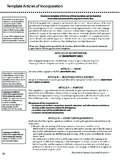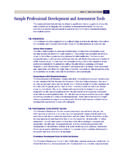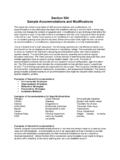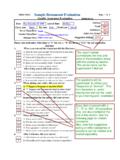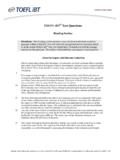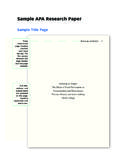Transcription of Sample bylaws — with membership - minnesotanonprofits.org
1 Sample bylaws with membershipHandbook for Starting a Successful Nonprofit Page 42 Article II is an example of a mem-bership organization s bylaws . For anexample of a non- membership orga-nization s bylaws , see page board of directors must decidewho will be eligible for membershipand if dues will be paid. This shouldbe laid out in the bylaws . The following bylaws are intended only as a model. They show some of themost general ways of writing bylaws . An organization has a great deal of lati-tude in shaping its bylaws , and does not need to follow this model. Keep inmind that the organization can and should amend its bylaws as often as neces-sary to keep up with changes to the organization. Organizations are free toreproduce all, or parts of the samples provided in this OFABCNONPROFITARTICLEI NAME AND PURPOSES ection 1 Name: The name of the organization shall be be a nonprofit organization incorporated under the laws of theState of MinnesotaSection 2 Purpose: ABCN onprofitis organized exclusively for charitable,scientific and education purposes.
2 The purpose of this corporation is: to support and conduct non-partisan research, education, and informational activities to increase public awareness of juvenile delinquency; to combat crime within neighborhoods; and to prevent community MEMBERSHIPS ection 1 Eligibility for membership :Application for voting membershipshall be open to any current resident, property owner, businessoperator, or employee of the city of Saint Paul that supports thepurpose statement in Article I, section is grantedafter completion and receipt of a membership application and annualdues. All memberships shall be granted upon a majority vote of 2 Annual dues:The amount required for annual dues shall be$100 each year, unless changed by a majority vote of the members atan annual meeting of the full membership . Continued membership iscontingent upon being up-to-date on membership dues.
3 section 3 Rights of members:Each member shall be eligible to appoint onevoting representative to cast the member s vote in association 4 Resignation and termination:Any member may resign by filing awritten resignation with the secretary. Resignation shall not relieve amember of unpaid dues, or other charges previously accrued. A mem-ber can have their membership terminated by a majority vote of 5 Non-voting membership :The board shall have the authority toestablish and define non-voting categories of person or organization cannotautomatically be made a law states that a personmay not be admitted as a memberwithout the person's express orimplied consent. Members are of one class, withequal rights, unless otherwise statedin the articles and I must be included. Fororganizations not incorporated,state that the nonprofit is organizedin compliance with the laws purpose statement must main-tain the standards stated in IRSP ublication 557 and give a briefdescription of the organization sgoals to ensure approval of Federaltax highlighted in bold type signifyinformation specific to the organiza-tion.
4 Other information provided inthis Sample may not be adequate forall types of nonprofits and are pro-vided only as an bylaws with membershipHandbook for Starting a Successful Nonprofit Page 43 ARTICLEIII MEETINGSOFMEMBERSS ection 1 Regular meetings:Regular meetings of the members shall be heldquarterly, at a time and place designated by the chair. section 2 Annual meetings:An annual meeting of the members shall takeplace in the month of October, the specific date, time and location ofwhich will be designated by the chair. At the annual meeting the mem-bers shall elect directors and officers, receive reports on the activitiesof the association, and determine the direction of the association forthe coming 3 Special meetings:Special meetings may be called by the chair, theExecutive Committee, or a simple majority of the board of directors.
5 Apetition signed by five percent of voting members may also call a spe-cial meeting. section 4 Notice of meetings:Printed notice of each meeting shall be givento each voting member, by mail, not less than two weeks prior to 5 Quorum: The members present at any properly announced meetingshall constitute a 6 Voting:All issues to be voted on shall be decided by a simplemajority of those present at the meeting in which the vote takes BOARDOFDIRECTORSS ection 1 Board role, size, and compensation:The board is responsible foroverall policy and direction of the association, and delegates responsi-bility of day-to-day operations to the staff and committees. The boardshall have up to 20, but not fewer than 16 boardreceives no compensation other than reasonable expenses. section 2 Terms:All board members shall serve two-year terms, but are eli-gible for re-election for up to five consecutive 3 Meetings and notice:The board shall meet at least quarterly, at anagreed upon time and place.
6 An official board meeting requires thateach board member have written notice at least two weeks in advance. section 4 Board elections:New directors and current directors shall be elect-ed or re-elected by the voting representatives of members at the will be elected by a simple majority of memberspresent at the annual meeting. section 5 Election procedures: A Board Development Committee shall beresponsible for nominating a slate of prospective board members rep-resenting the associations diverse constituency. In addition, any mem-ber can nominate a candidate to the slate of nominees. All memberswill be eligible to send one representative to vote for each candidate,for up to 10 available positions each 6 Quorum:A quorum must be attended by at least forty percent ofboard members for business transactions to take place and motions nonprofit with voting membersshould hold at least one meeting ofits members per otherwise specified by thearticles or bylaws , a quorum for ameeting of members is ten percentof the members entitled to vote atthe meeting according to law requires a minimumof three statutorylimit for a board term is ten years.
7 A board of directors must meet atleast once during a fiscal law requires a quorum ofdirectors for the purpose of con-ducting transactions, to consists ofat least one-third, of the directorscurrently holding more information on boardgovernance, see page bylaws with membershipHandbook for Starting a Successful Nonprofit Page 44 section 7 Officers and Duties:There shall be four officers of the board, con-sisting of a chair, vice-chair, secretary and treasurer. Their duties are asfollows:The chairshall convene regularly scheduled board meetings, shall preside or arrange for other members of the Executive Committee topreside at each meeting in the following order: vice-chair, secretary, vice-chairshall chair committees on special subjects as designatedby the secretaryshall be responsible for keeping records of boardactions, including overseeing the taking of minutes at all board meet-ings, sending out meeting announcements, distributing copies of min-utes and the agenda to each board member, and assuring that corporaterecords are treasurershall make a report at each board treasurershall chair the finance committee, assist in the preparation of the budg-et, help develop fundraising plans, and make financial informationavailable to board members and the public.
8 section 8 Vacancies: When a vacancy on the board exists mid-term, the sec-retary must receive nominations for new members from present boardmembers two weeks in advance of a board meeting. These nomina-tions shall be sent out to board members with the regular board meet-ing announcement, to be voted upon at the next board will be filled only to the end of the particular board mem-ber's 9 Resignation, termination, and absences:Resignation from theboard must be in writing and received by the Secretary. A board mem-bers shall be terminated from the board due to excess absences, morethan two unexcused absences from board meetings in a year. A boardmember may be removed for other reasons by a three-fourths vote ofthe remaining 11 Special meetings:Special meetings of the board shall be calledupon the request of the chair, or one-third of the board.
9 Notices of spe-cial meetings shall be sent out by the secretary to each board memberat least two weeks in COMMITTEESS ection 1 Committee formation:The board may create committees as need-ed, such as fundraising, housing, public relations, data collection, board chair appoints all committee 2 Executive Committee: The four officers serve as the members ofthe Executive Committee. Except for the power to amend the Articlesof Incorporation and bylaws , the Executive Committee shall have allthe powers and authority of the board of directors in the intervalsbetween meetings of the board of directors, and is subject to the direc-tion and control of the full to Minnesota law, a boardmust consist of at least a chair/pres-ident and a officescan be created as are assigned by theboard of directors to work on spe-cific issues facing the committees, such as anExecutive Committee or FinanceCommittee, should be outlined inthe bylaws , whereas ad hoc commit-tees can be created for a time peri-od set by the board of bylaws with membershipHandbook for Starting a Successful Nonprofit Page 45 section 3 Finance Committee.
10 The treasurer is the chair of the FinanceCommittee, which includes three other board FinanceCommittee is responsible for developing and reviewing fiscal proce-dures, fundraising plans, and the annual budget with staff and otherboard members. The board must approve the budget and all expendi-tures must be within budget. Any major change in the budget must beapproved by the board or the Executive Committee. The fiscal yearshall be the calendar reports are required to be submittedto the board showing income, expenditures, and pending income. Thefinancial records of the organization are public information and shallbe made available to the membership , board members, and the VI DIRECTORANDSTAFFS ection 1 Executive Director:The executive director is hired by the executive director has day-to-day responsibilities for the organiza-tion, including carrying out the organization s goals and policies.


